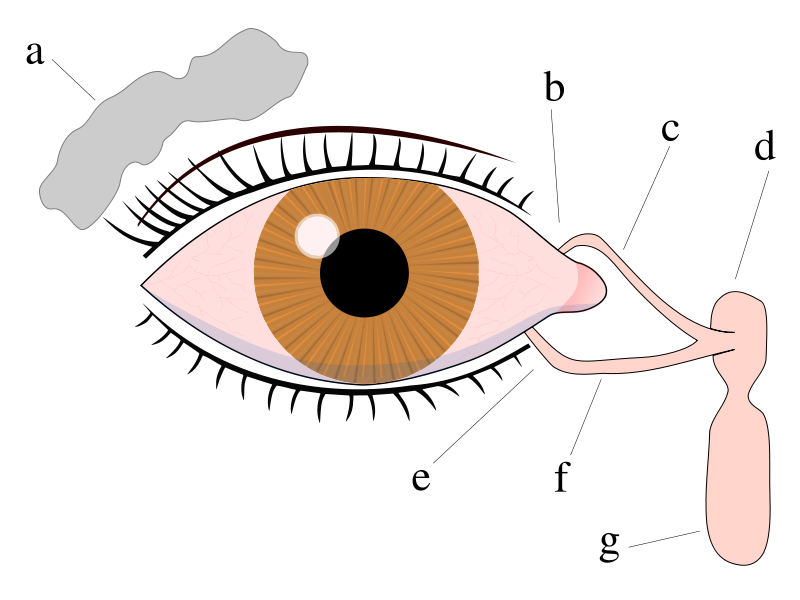Tears
Editor-In-Chief: C. Michael Gibson, M.S., M.D. [1]

Tears are a liquid produced by the body's process of lacrimation to clean and lubricate the eyes. The word lacrimation may also be used in a medical or literary sense to refer to crying. Strong emotions, such as sorrow or elation, may lead to crying. Although most land mammals have a lacrimation system to keep their eyes wet, Humans are the only animal generally accepted to cry emotional tears. [2][3]
Physiology
In humans, the tear film coating the eye has three distinct layers, from the most outer surface:
- The lipid layer contains oils secreted by the meibomian glands. The outer-most layer of the tear film coats the aqueous layer to provide a hydrophobic barrier that retards evaporation and prevents tears spilling onto the cheek.
- The aqueous layer contains water and other substances such as proteins (e.g. tear lipocalin, lactoferrin, lysozyme[1] and lacritin) secreted by the glands and the lacrimal gland. The aqueous layer serves to promote spreading of the tear film, control of infectious agents and osmotic regulation.
- The mucous layer contains mucin secreted by the conjunctival goblet cells. The inner-most layer of the tear film, it coats the cornea to provide a hydrophilic layer that allows for even distribution of the tear film, as well as mucus covering of the cornea.
Having a thin tear film may prevent you from wearing contact lenses as the amount of oxygen need is higher than normal and contact lenses stop oxygen entering your eye. You will find that your eyes will dry out while wearing contact lenses whilst having a thin tear film. Special eye drops are available for contact lense wearers, also certain types of contact lenses are designed to let more oxygen through.
Drainage of tear film
One lacrimal gland is located superiortemporally to each eye, behind the upper eyelid. The lacrimal glands secrete lacrimal fluid which flows through the main excretory ducts into the space between the eyeball and lids. When the eyes blink the lacrimal fluid is spread across the surface of the eye. Lacrimal fluid gathers in the lacrimal lake, and is drawn into the puncta by capillary action, then flows through the lacrimal canaliculi at the inner corner of the eyelids through the nasolacrimal duct, and finally into the nasal cavity. An excess of tears, as with strong emotion, can thus cause the nose to run. [4]
Types of tears
There are three very basic types of tears:
- Basal tears: In healthy mammalian eyes, the cornea is continually kept wet and nourished by basal tears. They lubricate the eye and help to keep it clear of dust. Tear fluid contains water, mucin, lipids, lysozyme, lactoferrin, lipocalin, lacritin, immunoglobulins, glucose, urea, sodium, and potassium. Some of the substances in lacrimal fluid fight against bacterial infection as a part of the immune system.
- Reflex tears: The second type of tears results from irritation of the eye by foreign particles, or from the presence of irritant substances such as onion vapors, tear gas or pepper spray in the eye's environment. These reflex tears attempt to wash out irritants that may have come into contact with the eye.

- Crying or weeping (psychic tears): The third category, generally referred to as crying or weeping, is increased lacrimation due to strong emotional stress, depression or physical pain. This practice is not restricted to negative emotions; many people have been known to cry when extremely happy or when they are laughing. In humans, emotional tears can be accompanied by reddening of the face and sobbing — cough-like, convulsive breathing, sometimes involving spasms of the whole upper body. Tears brought about by emotions have a different chemical make up than those for lubrication. The limbic system is involved in production of basic emotional drives, such as anger, fear, etc. The limbic system, specifically the hypothalamus, also has a degree of control over the autonomic system. The parasympathetic branch of the autonomic system controls the lacrimal glands via the neurotransmitter acetylcholine through both the nicotinic and muscarinic receptors. When these receptors are activated that the lacrimal gland is stimulated to produce tears.[2]
Diseases and disorders
Quality of vision is affected by the stability of the tear film.[3]
"Crocodile tears syndrome" is an uncommon consequence of recovery from Bell's palsy where faulty regeneration of the facial nerve causes sufferers to shed tears while eating.[4]
Keratoconjunctivitis sicca, more commonly known as dry eye, is a very common disorder of the tear film. Paradoxically, sufferers can experience watering of the eyes which is in fact a response to irritation caused by the original tear film deficiency.
"Leamy Eye" is a condition whereby there is excessive watering of one eye, seemingly for no apparent reason, in response to environmental stimuli.
Causes
Drug Induced
Societal aspects

|
WikiDoc Resources for Tears |
|
Articles |
|---|
|
Media |
|
Evidence Based Medicine |
|
Clinical Trials |
|
Ongoing Trials on Tears at Clinical Trials.gov Clinical Trials on Tears at Google
|
|
Guidelines / Policies / Govt |
|
US National Guidelines Clearinghouse on Tears
|
|
Books |
|
News |
|
Commentary |
|
Definitions |
|
Patient Resources / Community |
|
Directions to Hospitals Treating Tears Risk calculators and risk factors for Tears
|
|
Healthcare Provider Resources |
|
Continuing Medical Education (CME) |
|
International |
|
|
|
Business |
|
Experimental / Informatics |
Most mammals will produce tears in response to extreme pain or other stimuli, but crying as an emotional reaction is considered by many to be a uniquely human phenomenon, possibly due to humans' advanced self-awareness. Some studies suggest that elephants and gorillas may cry as well.[5]
In nearly all cultures, crying is seen as a specific act associated with tears trickling down the cheeks and accompanied by characteristic sobbing sounds. Emotional triggers are most often anger and grief, but crying can also be triggered by sadness, joy, fear, laughter or humor, frustration, or other strongly-experienced emotions.
In many cultures, crying is associated with babies and children. Some cultures consider crying to be undignified and infantile, casting aspersions on those who cry publicly, except if it is due to the death of a close friend or relative. In most cultures, it is more socially acceptable for women to cry than men.
Some modern therapy movements such as Re-evaluation Counseling believe that crying is beneficial to health and mental wellbeing, and positively encourage it.[6]
An insincere display of grief or dishonest remorse is called crocodile tears, from the ancient anecdote that crocodiles would pretend to weep while luring or devouring their prey.[7]
Spiritual aspects
Transpersonal psychology is scientifically investigating the mechanism and process of sublime tears of spiritual bliss and joy.[citation needed] Many religions describe gods or prophets as crying:
- According to a hadith, the prophet Muhammad proclaimed: "This (tears) is an expression of the tenderness and compassion, which the Lord hath put into the hearts of His servants. The Lord doth not have compassion on and commiserate with His servants, except such as are tender and full of feeling."
- The shortest verse in English translated Bibles is found in the Gospel of John 11:35, "Jesus wept."
- Jade is sometimes known as "tears of the Buddha".
The Gift of Tears in Shin Buddhism: Tears of joy and grief cleanse our souls. Christians as well may perceive tears as a spiritual gift when they refer to Gospel of Jesus Christ: "Blessed are you that weep now, for you shall laugh" (Luke 6.21), while Weeping Icons are a common feature of the Eastern Christian Traditions.
References
- ↑ http://www.medrounds.org/ocular-pathology-study-guide/2005/10/tear-proteins.html
- ↑ Skorucak A. "The Science of Tears." ScienceIQ.com. Accessed September 29, 2006.
- ↑ Szczesna DH, Jaronski J, Kasprzak HT, Stenevi U. "Interferometric measurements of dynamic changes of tear film." J Biomed Opt. 2006 May-Jun;11(3):34028. PMID 16822077.
- ↑ http://www.ncbi.nlm.nih.gov/entrez/query.fcgi?cmd=Retrieve&db=PubMed&list_uids=2261223&dopt=Abstract
- ↑ Masson, Jeffrey Moussaieff, McCarthy, Susan, When Elephants Weep, Delta 1996 isbn: 978-0385314282
- ↑ Re-evaluation Counseling site: "The Recovery Process"
- ↑ http://www.worldwidewords.org/qa/qa-cro1.htm
External links
- Nasolacrimal System Anatomy - eMedicine.com
- The Spiritual Context of Tears - The Gift of Tears